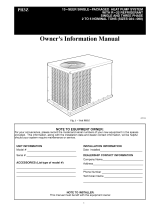
12
3. Connect the heating speed wire (red) and the cooling
speed wire (black) to the desired blower speed marked
on the terminal block of the blower motor.
• Terminal4=Hispeed
• Terminal5=Medspeed
• Terminal6=Lowspeed
4. Replace the upper door and secure it to the unit.
5. Restore power to the unit.
High Efficiency Units (Variable & Fixed Speed)
IMPORTANT! This air handler has been designed to
give the installer maximum flexibility to optimize system
performance, efficiency, and comfort. Because there are so
many different ways to set up the air handler it is important
to read and follow these directions carefully.
B7EM & B7VM air handlers use high efficiency circulating
air motors that come in two variations and both are
controlled differently. The fixed speed motor control board
(Figure 12, page 23) controls the torque and the variable
speed motor control board (Figure 13) controls the airflow at
a constant CFM. Both boards use the same control board.
Before operation, the air handler must be configured to
match the unit with the system, system options, and climatic
conditions. When configured, the air handler responds
directly to the thermostat inputs, as well as the optional
humidistat (see page 12). During normal operation, the
motor will gradually change speeds during start-up, shut
down, when thermostat inputs change, and when the duct
static pressure changes (vents closed or opened, filter
clogging, etc.). The air handler is configured by setting
the selector switches and removing jumper connectors.
Selecting Basic Heating Airflow
Fixed & variable speed motor control boards (Figures 12
& 13) contain a set of dip switches for setting the blower
speed. For MB7EM models, pins 1-4 set the speed for
heating. For MB7VM models, the A/B switch must be set for
the appropriate cabinet size (either setting can be used for
C-size cabinets). The airflow is set automatically based on
the amount of installed heat. For both MB7EM & MB7VM
models, the cooling speed is selected via switches 5,6,7,&
8. To determine the appropriate switch settings for your
installation, see Tables 5 - 8 (pages 17-19).
Selecting Basic Cooling / Heat Pump Airflow
The basic cooling/heat-pump airflow is controlled by setting
switches 5 - 8 on the motor control board (mounted on the
blower). All airflows for other modes of operation (except
electric heat) are determined by this basic setting. FAN
ONLY would deliver 50% of the selected cooling airflow.
Table 5 lists the basic airflow values versus the airflow
selector switch settings and ranges of basic air flow
settings recommended for each nominal system capacity.
• When operating in the heat pump mode, a higher basic
airflow setting will increase the energy efficiency and
capacity but will also decrease the supply air temperature.
• For maximum capacity and energy efficiency, select an
airflow at or near the top of the range for that nominal
capacity. See Table 7 (page 18).
• For maximum dehumidification, select an airflow near the
middle or bottom of the range for that nominal capacity.
Additional information on humidity control can be found
in the Humidistat and Delay Setting sections.
• For thermostats with a dehumidifier output, use a field
supplied wire to connect the thermostat’s dehumidifier
output to the terminal marked DHUM. The thermostat
should be set so that the DHUM output should be high
(energized) when dehumidification is needed. See also
Dehumidification Options section.
IMPORTANT! If coil icing is observed, the basic cooling/
heat-pump airflow selected may be too low. Verify the
setting selected is within the range shown in Table 7 and
that the the system is properly charged. Please refer to the
instructions supplied with the outdoor unit. If icing continues
to occur, raise the selected airflow one or two steps.
NOTE: Variable speed air handlers with SEER ratings
higher than 15 are matched with a 2-stage cooling outdoor
unit. They are programmed to operate at 75% of the
selected airflow while the system is in the lo-cool mode
and 100% of the selected airflow while in hi-cool mode.
Dehumidification Options
(B7EM or B7VM Models Only)
Both motor control boards (Figures 12 & 13, page 23)
have a DHUM connection that allows the system to
increase the amount of humidity that is removed from
the circulating air. This is accomplished by reducing the
CFM and allowing the cooling coil to become colder. This
will only occur when there is a call for cooling. There are
many ways that this can be electrically wired.
1. If the room thermostat incorporates a humidity sensor
and DHUM output, connect the DHUM on the thermostat
to the DHUM terminal on the motor control board.
2. If using a separate humidistat, connect the DHUM & R
terminals on the humidistat to the DHUM & R terminals
on the motor control board of the air handler. In this
option, the DHUM output of the humidistat must be set
to be normally open and closed when there is a call for
humidification. See Figure 6.
3. If a humidistat is not available, it is an acceptable option
to connect the R & DHUM terminals on the motor
control board together with a field supplied wire. This
option causes the blower to run at a reduced CFM for
10 minutes after a call for cooling. NOTE: If outdoor unit
is a heat pump, connect the O terminal to DHUM.
DHUM
R
R
DHUM
HUMIDISTAT
MOTOR
CONTROL BOARD
Figure 6. DHUM Wiring Configuration




















